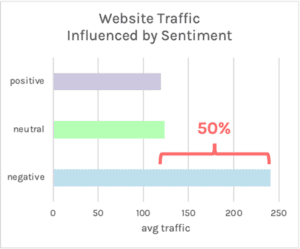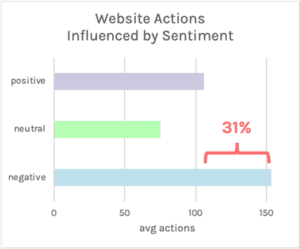This week, we’re wrapping up our How Earned Media Drives Consumer behavior blog series with a review of the relationship between brand sentiment and website traffic and actions.
These insights are based on our quantitative analysis of the PR Attribution™ data from over 100,000 earned media articles published in 2021 that covered both business-to-consumer and business-to-business brands across a wide range of industries.
Brand sentiment and consumer behavior
Brand sentiment is the tone and sentiment of an article towards the company or brand being mentioned. Onclusive’s brand sentiment accounts for positive, negative, or neutral tone based on our advanced artificial intelligence (AI) and semantic analysis.
This is the most unexpected finding of all. In our study, we discovered that sentiment is negatively correlated with both website traffic and website actions.
The trend actually is inverted, with negative articles driving the most website traffic, neutral sentiment articles driving the second most website traffic, and positive sentiment articles driving the least website traffic.
“It is evolutionarily advantageous to prioritize negative
information because the potential costs of negative information
far outweigh the potential benefits of positive information. The
human brain is as a consequence predisposed towards focusing
on negative information. Negative news content in comparison
with positive news content tends to increase both arousal and
attentiveness.” Stuart Soroka Professor of Communication Studies and Political Science, and Faculty Associate in the Center for Political Studies at the Institute for Social
Research, University of Michigan
On average, positive sentiment articles drive 50.4% less traffic than negative sentiment articles, and neutral sentiment articles drive 48.7% less traffic than negative sentiment articles. Also, positive sentiment articles drive 3.4% less traffic than neutral sentiment articles.
Similarly, positive sentiment articles result in 31% fewer website actions than negative sentiment articles, but positive sentiment articles do drive more (41.4%) website actions than neutral sentiment articles:


Website actions like signs up, purchases, and pages viewed, are a strong indicator of brand awareness and interest from your audience. Therefore, based on our findings, the quality of your website content is equally important both in good times and during a crisis. How you handle the crisis and turn around negative press makes all the difference.
So while the adage “all press is good press” may not necessarily be true as it relates to brand reputation, it does appear that negative media coverage drives more website activity. Conceivably, people are more interested in learning about companies with negative press than in those with positive press.
Overall, it’s a good idea to both ensure a consistent flow of positive content and always maintain a solid crisis management plan. Even during a crisis, you can generate significant interest in your brand. Take the opportunity to influence consumer behavior in a positive way.
Key takeaways from our research
In summary, we thought we’d share all of the key takeaways from our study to explore the relationship between the core earned media attributes and consumer behavior. Specifically, website traffic and actions measured by PR Attribution™:
1. Connect with niche content sites, blogs and lower-reach publications to drive more quality visitors to your website.
2. Build relationships with Tier One and other high-reach outlets to increase desired website actions from your audience.
3. Keep in mind that you can receive as much benefit from being mentioned in an article that is highly relevant to your industry or category as you do from “feature” stories about your brand.
4. Content is still king! Make sure that your website has great content and effective calls to action, both during good times and crises.
5. Use comprehensive media monitoring or social listening to identify the most engaging content. Produce more of it to increase both your website visitation and activity.
6. Maximize consumer interest in your brand by generating a consistent flow of positive earned media articles. Also maintain a solid crisis management plan to respond to negative articles.
Want more insights? Join Onclusive for the How Earned Media Drives Consumer Behavior: A Quantitative Analysis webinar on June 8th. Our panel of communications and data experts will reveal which media attributes – such as publication authority, reach, article relevance, brand sentiment and reader engagement – are key to driving action from your audience. We’ll also discuss how this data can help you improve your communications performance.
